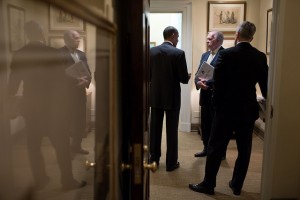Maybe the Gimmick Is in the Timing of Legion of Doom?
In my first post on this Yemen scare — which I will henceforth call “Legion of Doom” in honor of the Daily Beast source’s use of the term — I suggested the big part of the plot might have already transpired.
There’s the increased drone activity in Yemen. Who knows! Maybe, like last year, the plot has already been rolled up and we’re just waiting to confirm one of the several recent drone strikes have taken out our target?
I made that suggestion because of evidence that the US rolled up UndieBomb 2.0 on April 20-24 of last year, and only then deployed a bunch of Air Marshals and fear-mongering about Ibrahim al-Asiri for the days leading up to the May 1 anniversary of Osama bin Laden’s killing. They eliminated the threat (which was minimal in any case, since the bomber was a British-Saudi-US mole), then rolled out fear-mongering about it, as if the threat still existed. Fairly clearly, the White House planned a big press conference on their operation once they killed Fahd al-Quso, and thus got furious when the AP managed to scoop their theater.
I increasingly think that may be the case. Whether or not there was ever a real threat, I suspect it may have partly passed before the big rollout of it last Friday (though the targeting of a top AQAP member, the presence of additional JSOC forces, or all the drone strikes may have increased the risk for Americans in Yemen).
Consider: back when Pentagon stenographer Barbara Starr was among the first to discuss the intercepts behind Legion of Doom, she suggested very fresh SIGINT chatter and a warning from President Abdo Rabi Mansour Hadi delivered on July 31 or August 1 had led the US to close a bunch of embassies (though even there, they waited a few days to start closing embassies).
Fresh intelligence led the United States to conclude that operatives of al Qaeda in the Arabian Peninsula were in the final stages of planning an attack against U.S. and Western targets, several U.S. officials told CNN.
The warning led the U.S. State Department to issue a global travel alert Friday, warning al Qaeda may launch attacks in the Middle East, North Africa and beyond in coming weeks. The U.S. government also was preparing to close 22 embassies and consulates in the region Sunday as a precaution.
The chatter among al Qaeda in the Arabian Peninsula operatives had gone on for weeks but increased in the last few days, the officials said.
Taken together with a warning from Yemeni officials, the United States took the extraordinary step of shutting down embassies and issuing travel warnings, said the officials, who spoke on condition of anonymity.
While the specific target is uncertain, U.S. officials are deeply worried about a possible attack against the U.S. Embassy in Yemen occurring through Tuesday, the officials said.
[snip]
Yemeni intelligence agencies alerted authorities of the threat two days ago, when the Yemeni president was in Washington, said the official, who spoke on condition of anonymity. [my emphasis]
And the original and an update to the NYT’s original story on Legion of Doom says the intercept between Zawahiri and Wuhayshi came sometime last week.
The intercepted conversations last week between Ayman al-Zawahri, who succeeded Osama bin Laden as the head of the global terrorist group, and Nasser al-Wuhayshi, the head of the Yemen-based Al Qaeda in the Arabian Peninsula, revealed what American intelligence officials and lawmakers have described as one of the most serious plots against American and Western interests since the attacks on Sept. 11, 2001.
But the latest AP version of the intercept call says it was picked up “several weeks ago.”
A U.S. intelligence official and a Mideast diplomat said al-Zawahri’s message was picked up several weeks ago and appeared to initially target Yemeni interests. The threat was expanded to include American or other Western sites abroad, officials said, indicating the target could be a single embassy, a number of posts or some other site. Lawmakers have said it was a massive plot in the final stages, but they have offered no specifics.
Perhaps the discrepancy comes from confusion about two different Zawahiri-Wuhayshi intercepts. In its conference call report, the Daily Beast reports that authorities picked up a communication, via courier, between Zawahiri and Wuhayshi “last month.”
An earlier communication between Zawahiri and Wuhayshi delivered through a courier was picked up last month, according to three U.S. intelligence officials.
That earlier conversation may simply have been Zawahiri naming Wuhayshi his deputy, but the role of a courier in the interception suggests they may have gotten far more intelligence — perhaps not just intelligence tipping the US off to whatever conference call protocol AQ was using, but also to the location of Wuhayshi and other figures.

